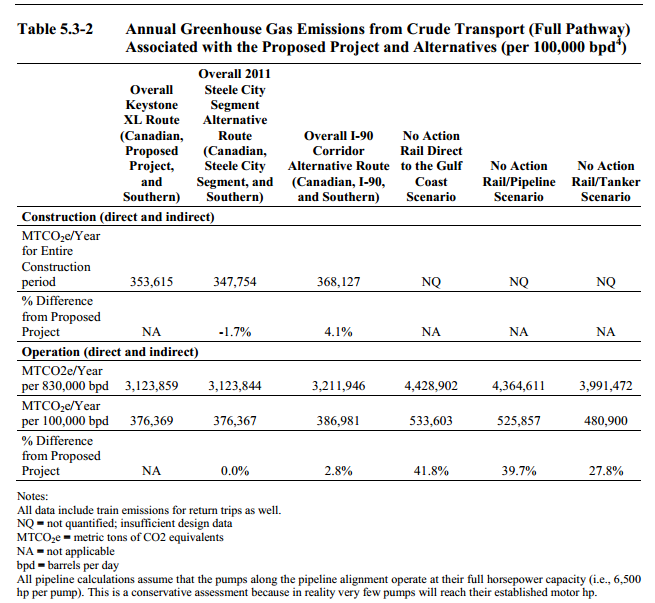![]()
Sean Hackbarth:
President Obama tossed economics and science out the window and onto the White House lawn when he rejected the Keystone XL pipeline.
After leaving it in bureaucratic limbo for seven years, the president claimed the project–which would safely transport Canadian and American crude oil to Gulf Coast refineries–would have little economic effect and would hurt U.S. leadership in reducing carbon emissions.
Both claims are bunk, as the State Department’s analysis shows.
Let’s first take up President Obama’s economic argument.
“The pipeline would not make a meaningful long-term contribution to our economy,” President Obama said at a White House event.
The State Department’s analysis disagrees:
- 42,000 jobs would be created.
- $3.4 billion would be added to the U.S. economy.
- $405 million would be earned by workers building the pipeline in Montana, South Dakota, and Nebraska.
- $55 million in property tax revenue would go to local communities.
What America lost when @POTUS denied the #KeystoneXL pipeline: pic.twitter.com/rDa8D9Pjui
— Global Energy Inst (@globalenergy) November 6, 2015
Not only did President Obama tossed aside the Keystone XL pipeline’s economic benefits, he also ignored the science showing that the project’s environmental effects will be minimal.
“America is now a global leader when it comes to taking serious action to fight climate change,” President Obama said. “And frankly, approving this project would have undercut that global leadership.”
The only thing the Keystone XL pipeline would undercut it America’s reliance on oil from unfriendly countries. It certainly wouldn’t undercut efforts to reduce carbon emissions.
In fact, the State Department found that not building the pipeline would result in higher greenhouse gas emissions, increases ranging anywhere from 28%-42%.
But as Phil Kerpen tweeted, the administration is more concerned about perception than real science.#KeystoneXL was rejected not because it ACTUALLY increases global warming but because of PERCEPTION that it does. pic.twitter.com/HsAHt2sgO6
— Phil Kerpen (@kerpen) November 6, 2015
The truth is, our president–a “science geek” according to his top science advisor–rejected science and instead chose to side with anti-energy opponents of the pipeline.
The reaction to President Obama’s decision was strong and swift.
“In rejecting the Keystone XL pipeline, President Obama has put politics before the best interests of the country,” said U.S. Chamber President and CEO Tom Donohue. “Rejecting Keystone breaks two promises the president made—to put jobs and growth first and to seek bipartisan solutions.”
President and CEO of the American Petroleum Institute Jack Gerard said: “This decision will cost thousands of jobs and is an assault to American workers. It’s politics at its worst.”
Labor union leaders were beyond disappointed.



Why is this man still in office? Oh right the GOP has no balls.
Well the liberals depending on union support must be saying “heres another fine mess you’ve gotten us into.”
Tossing another ally under the bus, it’s Canada we would be working with, helping them with oil production aiding them economically. Jan 2017 can’t come fast enough. Too late for impeachment that process takes way to long.
The product is still going to be extracted and refined. It just won’t go through a pipe.
Obama is doing nothing but killing jobs. The environment will not be changed for better or worse because of his actions.
On one hand he’s a master of the meaningless and on the other a fool of epic proportions.
As long as the pipeline is not completed, Obama’s buddy, Warren Buffet gets to haul all of that North Dakota light crude to Texas and Oklahoma on his BN railroad. On the way, what are a few dead people in Canada and derailments so oil can spill into our creeks and rivers? This was just to pay off his friends like he did with the solar and wind machine loans.
Don’t say nobody saw it coming. Environmentalists, Native American residents, and the Obama administration saw it coming.
This little 210,000 gallon accident won’t be be the end of it. Wait until it happens over a shallow area of aquifer and contaminates the groundwater. Do we have any technologies to clean that up? That’s question having a yes or no answer. Which do you think it is?
November 16, 2017 – Keystone pipeline spills 210,000 gallons of oil on eve of permitting decision for TransCanada
From FOX News, October 31, 2019 – Keystone pipeline leaks oil in northeastern North Dakota
The “unknown amount” making that brown stain on the North Dakota landscape in the aerial photograph consists of an estimated 383,000 gallons of petroleum. Fortunately the flowing water it’s spreading toward in the drainage ditch just to the right poses no environmental threat, since the Trump administration previously rescinded EPA regulations concerning the contamination of agricultural drainage ditches.
Keystone has been shut down by the pipeline owner until they figure out why their pipe is transporting oil to a North Dakota field. It’s difficult to inspect, since it’s buried. You can’t tell you have a leak until the ground becomes sufficiently saturated for oil to be pushed to the surface. Then you might only be seeing the tip of the iceberg. Here’s a helpful rule to remember: The surface is up; the water table is down.
@Greg: Pipelines remain a safer and cleaner way to transport crude than rail or truck.
@Greg: Actually you can because there is sensors all over the pipe line. This leak didn’t cause the death of so many people like the train derailment did. Greg, you have no idea how they clean up oil spills. You do know that oil is an organic that can be reduced to its elemental forms by bacteria. That is why the thousands of gallon of crude oil that seeps into the Gulf of Mexico from natural fissures in the Gulf floor causes little problems. Trump changed the regulation because the law was passed to regulate navigable waters, not farm ditches.
From 2012 – Keystone XL Will Not Use Advanced Leak Detection
This was always part of the concern.